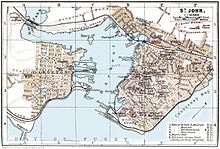|
Port of Saint John
The Port of Saint John is a port complex that occupies 120 hectares (300 acres) of land along 3,900 m (12,800 ft) of waterfront of the Saint John Harbour at the mouth of the Saint John River in the city of Saint John, New Brunswick, Canada.[5] The Port of Saint John, with facilities on both sides of the river, is noted for its extreme tidal range and river currents. Because of the semi-diurnal tides and the river influence, slack water occurs at approximately half tide and not at high or low water as at most other ports.[6] The port is administered by the Saint John Port Authority, a federal agency. Major products shipped through the port include oil, forest products and potash. Container traffic has been steadily increasing since 2016 with DP World becoming the port operator and Canadian Pacific regaining access to the port in 2020 through the purchase of Central Maine and Quebec Railway. The port of Saint John has three container lines servicing it those being MSC, CMA CGM and Hapag-Lloyd. History The Port of Saint John lies within Mi'gma'gi, the Mikmaw Nation ancestral stewardship region and greater Wabanaki Confederacy ancestral governance area. The location was first visited by Samuel de Champlain on his voyage of discovery to the New World in 1604, who described the Saint John River as "one of the largest and deepest we had yet seen" and who was advised by his Mi'kmaq guides that the river provided a route to the Saint Lawrence River valley with only a short portage.[7] Because of its strategic location, it became the site of a French stronghold known as Fort La Tour. Though the fort was sacked in 1645, the river remained an important trade route for French, English and First Nations traders throughout the 17th and 18th centuries. The port did not begin to develop in earnest until the influx of United Empire Loyalists in 1783. It developed rapidly as a result of timber trade and shipbuilding. Saint John became the province's leading industrial centre during the 19th century with much of the shipbuilding industry being concentrated on Courtney Bay outside the main harbour area. One of the best known ships built in Saint John was the Marco Polo (1851) which became renowned for its speed. The Great Famine of Ireland of 1845–1849 saw a large immigrant influx, and to handle the new arrivals, the government constructed a quarantine station and hospital on Partridge Island at the mouth of the harbour. The immigration station continued to operate for many decades. In 1859, Partridge Island also became known as the site of the first successful demonstration of an automated steam-powered foghorn, invented by the Scotsman Robert Foulis who had settled in the city. The foghorn is "ranked by historians as one of the most outstanding in the development of navigation aids."[8]  For many years, the Port prospered as the winter port for Montreal. In 1889 the Canadian Pacific Railway opened a line across the state of Maine from Montreal to Saint John and transferred the majority of its trans-Atlantic passenger and cargo shipping to the port during the winter months. During the First World War, the Port of Saint John became a trans-shipment point for the British Empire's war effort. It had less importance during World War II as the navy focus had been consolidated in Halifax. The port suffered a decline following the opening of the St. Lawrence Seaway and the introduction of icebreaker services in the Seaway in the 1960s. In 1994 CPR left Saint John when it sold the line to shortline operator New Brunswick Southern Railway. The Canadian National Railway still services Saint John with a secondary mainline from Moncton. CPR made a return in 2020 with the purchase of Central Maine and Quebec Railway that connects with Irving owner NBSR in Brownville Junction Maine. Since being under operation by DP World, six cranes have been added to the port: two in 2017, two in 2023, and two previously used at the Port of Virginia in November 2024, which are the largest cranes the port has received to-date.[9] Port facilitiesThere are several marine facilities situated on either side of the harbour. The west side of the harbour includes:
The east side of the harbour includes:
Former facilities:
See alsoReferences
Further readingWikimedia Commons has media related to Port of Saint John.
|
||||||||||||||||||||||||||||||||||||||||||||


